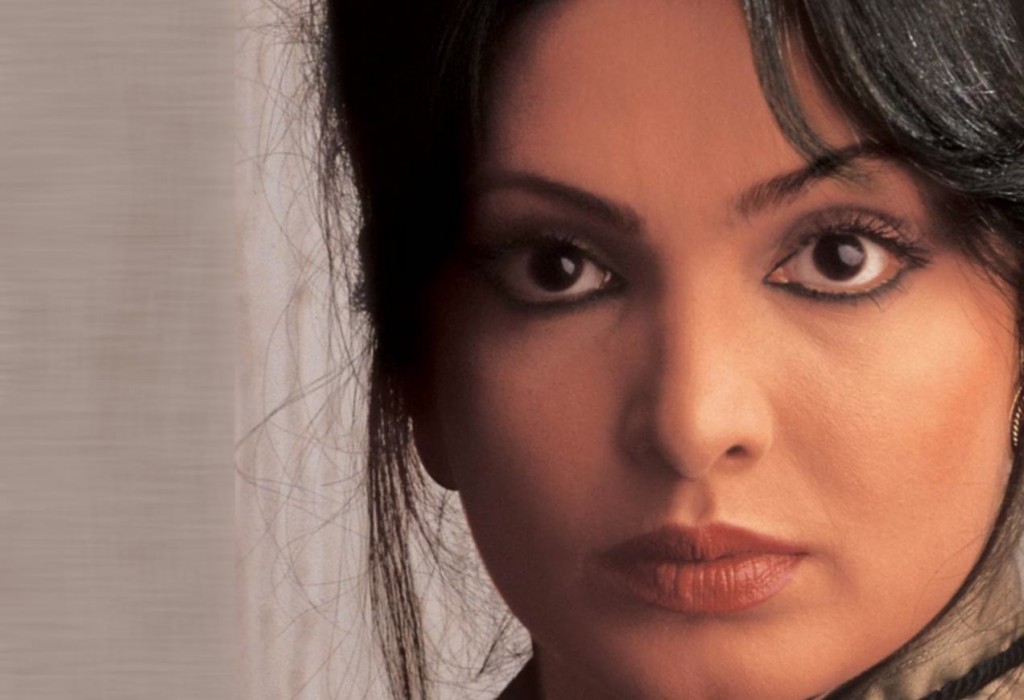Well-known Bollywood leading lady of the 1970s and early 1980s, Parveen Babi’s name has always been taken along with Zeenat Aman as the two women who changed the face of the Hindi film heroine in the 1970s. Both were normally typecast as the glamorous, sexy, westernized woman but there is a major difference between them that cinegoers and even film critics chose to ignore. While Zeenat Aman was never a great actress throughout her career, Babi was, in fact, an extremely competent performer given the chance. This is apparent when one sees her fine performances in films like Deewaar (1975), Burning Train (1980), Yeh Nazdeekiyan (1982), where she played the other woman, and especially Rang Birangi (1983), where she showed a fine knack for light comedy.
Babi, who came from Junagadh in Gujarat, was born on April 4, 1954. She was discovered at Ahmedabad, while still studying for her Bachelor of Arts in English Literature, by filmmaker BR Ishara. She subsequently made her debut with his film Charitra (1973) opposite dashing cricketer, Salim Durrani. The film was a resounding flop but Babi was noticed and received more offers. She had her first commercial success the following year with the taut thriller Majboor opposite Amitabh Bachchan, a popular pairing which would result in them doing 7 more films opposite each other.
Babi really came to the forefront with Yash Chopra’s Deewaar (1975), beautifully portraying the whore with the heart of gold – the gangster’s moll opposite Bachchan. Though the screen time of her role was not very well, she made the role her own with a fine performance as she went totally against the normal conventions of the respectable ‘Hindi film heroine.’ Openly flaunting her smoking and drinking and going to bed with her lover, she gave a well-rounded act while making her death scene one of the more memorable and heart-breaking scenes of the film.
It was Amar Akbar Anthony (1977), however, that took her to the peak of her career. Essentially a multi-starrer, which like most other muti-starrers of its time focused on male bonding of its heroes, the heroines were there just to provide mandatory glamour and romance but even here, Babi as the westernized Jenny easily outshone the other heroines of the film – Shabana Azmi and Neetu Singh. Who can forget her dancing to My Name is Anthony Gonzalves at the Easter Celebration Sequences! Meanwhile, in 1976, she was featured on the cover of the prestigious Time Magazine, the first Indian actress to have this honor.
Like most of the characters of her films, Babi too lived her life in a carefree and bohemian manner. Part of the hip Juhu crowd of the 1970s, she got deeply involved with actor Kabir Bedi. When Bedi went to the West to make a name for himself as an actor there, Babi followed her heart and threw away her flourishing career opting to go with him. She later came back and fortunately for her, the film industry welcomed her back with open arms. Big films followed – Shaan (1980), Kaalia (1981), Namak Halal (1982) to name some. She was unforgettable in the last named playing the sexy vamp (under duress as her mother is held captive) sent to kill Shashi Kapoor. Her gyrations to Jawani Jaan-e-man and Raat Baaki made them arguably the most popular songs of her career.
During this time she also attempted two films Yeh Nazdeekiyan and Rang Birangi to explore new avenues as an actress. And to her credit, she scored in both – as the other woman in the former who moves in with her married lover and as the neglected wife of Amol Palekar in the latter, displaying a fine sense of comic timing.
Babi had also had an intense relationship with filmmaker Mahesh Bhatt in the late 1970s when she came back following her break-up with Bedi. It was during this relationship that she began showing the first signs of the paranoid schizophrenia in which a victim is prone to all sorts of grandiose delusions and hallucinations. She had a nervous breakdown and Bhatt later went on to exploitatively document this in his film Arth (1982), where the character of the other woman, played memorably by Smita Patil, was based on Babi.
In the mid 1980s, a mentally disturbed Babi suddenly took off again, this time leaving an industry that never forgave her for just upping and leaving like that. She was never treated as part of the Film industry thereafter and shunned even when she returned in 1990. She looked all bloated and came up with all sorts of accusations against Bachchan for trying to kill her and claiming she had solid evidence of Sanjay Dutt’s involvement in the Bombay Bomb Blasts of 1993. She even said that the Bhuj earthquake was caused as an intended attack by inducing implosions under the earth’s surface beneath her home state of Gujarat. She had, it seemed, lost her mind completely. But rather then anyone coming forward to help her, she was just mercilessly ridiculed and laughed at.
A not-so successful attempt at a career in Interior Decoration saw her isolate herself totally from the world and she was found dead in her apartment on January 22, 2005. In fact, her death only came to be noticed when the milkman of her building alerted the building secretary that her milk and newspapers were unclaimed for two days. The police opened the door and found her dead. She was found to be diabetic and her neglect of herself had led her to having gangrene on her foot. Her funeral was sparsely attended with hardly anyone from the Film Industry attending.
Some of Parveen Babi’s other memorable films include Kaala Patthar (1979), Suhaag (1979), Kranti (1981), Khud-Daar (1982) and Arpan (1983).


